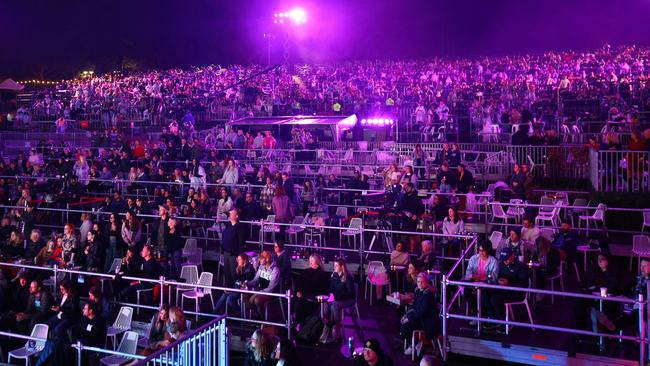Unsporting bias fails the Pub Choir test
For much of the past 14 months, the notion of large crowds gathering to sing together hasn’t exactly been welcomed with open arms by state health departments.

For much of the past 14 months, the notion of large crowds gathering to sing together hasn’t exactly been welcomed with open arms by state health departments.
For Brisbane community singing event Pub Choir — where people are taught to sing a popular song in three-part harmony, often with a beer in hand — the cessation of live gigs due to the pandemic meant a detour into “couch choir” events, where people filmed themselves singing along at home.
On Sunday, Pub Choir conductor Astrid Jorgensen and musician Waveney Yasso will return to the stage to lead their biggest hometown show to date.
Held at the Brisbane Riverstage, which usually admits up to 9500 people, Queensland Health restrictions will instead allow a maximum of only 4237 attendees learning to sing a Bee Gees song together.
“It’s bittersweet,” says Jorgensen. “We’ve been building up to this for four years, and now we can finally get there, it’s not quite how I imagined. But I’m excited: it feels like hallowed ground.”
As one of Brisbane’s largest outdoor venues, the Riverstage — an amphitheatre opened in 1989 which faces the city’s central waterway — has in the past week hosted concerts by popular artists including Tones and I, Violent Soho, The Avalanches and Ball Park Music.
Each show was restricted to a maximum of 3480 ticket holders. Yet other outdoor events held across the city last weekend were unrestricted: at Suncorp Stadium, 21,322 rugby league fans watched the Broncos take on the Titans, while 20,007 people watched the Lions and Port Adelaide play an AFL match at The Gabba.
The situation in Brisbane is mirrored nationwide, where an apparent double standard continues to be applied to the live music industry long after normalcy has returned to crowds attending televised live sporting matches.
On Anzac Day, for instance, 78,113 fans watched an AFL game at the Melbourne Cricket Ground in a world record crowd for the post-pandemic era. Yet the night before, the Music From the Home Front concert was held across the Yarra River at the Sidney Myer Music Bowl before a reduced capacity crowd of 2800, most of whom were confined to socially distanced group “pods” on the lawn. The Melbourne venue’s usual capacity for general admission shows is about 13,000.

In response to questions from The Weekend Australian regarding venue restrictions, a Queensland Health spokesperson said: “Currently, all large-scale venues such as sports stadiums, concert venues, theatres and jazz clubs are allowed to be at 100 per cent capacity if all attendees are ticketed, allocated and seated. Indoor venues can also operate at 100 per cent capacity if all attendees are ticketed, allocated and seated.
“If all attendees are seated and accounted for, the transmission risk is minimised and the ability to contact trace is made much easier,” said the spokesperson.
When asked about the scientific basis for this differentiation, Queensland Health did not address the question, and instead offered a general statement:
“Current restrictions exist because we know there is an increased risk of transmission at venues without allocated seating such as restaurants, cafes, music halls, pubs and nightclubs where there is typically high flow of people, movement of people, and where people may mingle.”

The Pub Choir conductor notes football fans aren’t parachuted into their allocated seats at a stadium: they catch the same public transport, they queue together to enter and exit, and they use the exact same bathroom and bar facilities as those set up for concerts, regardless of whether an event is held indoors or outside.
“Until we can get back to full capacity in live music in the same way that sport has, the industry will continue to suffer greatly,” says Jorgensen.
“When it is publicly declared that music events are ‘less safe’ than sporting events — even though we are using the same mouths and bodies to attend both of those things — it makes it even harder for us to convince the public that we are OK, that we are something worth supporting.”





To join the conversation, please log in. Don't have an account? Register
Join the conversation, you are commenting as Logout